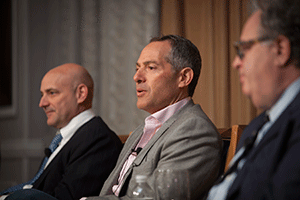CMBS: A Retrospective

On Thursday, April 24, 2014, the Cornell Center for Real Estate and Finance (CREF) hosted a breakfast and panel titled CMBS: A Retrospective, at the Pierre Hotel in New York. CREF Center Director and panel moderator Professor Daniel Quan of the Cornell School of Hotel Administration led an active discussion of how the CMBS market started, the benefits this way of financing commercial real estate provided, and some of the things that could have been done better then and now. Over 100 real estate finance professionals and current students attended the two hour event.
The panel members included
Dean Adler
Mark Finerman
Joseph Franzetti
Ethan Penner
Mark Snyderman
Following introductions by Professor Quan, Ethan Penner was asked to talk about how he became involved in generating loans and issuing mortgage backed securities for commercial real estate. Mr. Penner explained that he worked as a residential mortgage backed securities trader and happened upon a situation during the early 1990s in which an owner of a portfolio of commercial properties was having difficulty finding refinancing capital despite only seeking a 50 percent loan-to-value. The realization that this type of deal was likely prevalent in the market in the aftermath of the real estate crash of the late 1980s encouraged Mr. Penner to begin assembling the infrastructure necessary to securitizes commercial property loans on a large scale which eventually transitioned into the now famous Nomura CMBS operation of the 1990s.
Mr. Penner then turned to the panel members and asked what do you retrospectively think was the biggest benefit of CMBS? The panel including Mr. Penner offered the following five insights
- 1. The emergence of CMBS brought liquidity to a heretofore highly illiquid market, thus lowering the cost of commercial mortgage financing by broadening the capital base.
- 2. Lower capital cost was realized through the tranching of risk. Through both maturity and risk intermediation investors could now choose the tranch of an issue that fit their respective risk profile.
- 3. Prior to the existence of CMBS the dominant commercial property lenders – regulated commercial banks and life insurance companies who make mostly high, A-quality loans dominated the market. With the advent of relatively unregulated CMBS, borrowers with lower quality collateral and reputations were able to find affordable financing.
- 4. Until CMBS arrived on the scene the worlds of commercial real estate and fixed income were far apart. All that changed when commercial mortgages were converted to bonds through the CMBS issuing process. This unification built trust and thus served to further broaden the capital base for commercial property finance.
- 5. The CMBS innovation brought ‘responsive debt capital’ to a financing system characterized by expensive and frustrating time delays.
Mr. Penner then asked the members of the panel to expound on the biggest mistakes made in the developing and expanding the CMBS market. The panel offered the following opinions
- 1. The CMBS delivery system was and is unfortunately focused on the quantity of cash flows and not paying enough attention to the quality of cash flows.
- 2. The relationship between the lender and borrower was not fostered in CMBS, from loan origination through maturity.
- 3. The penalties for misbehavior both by borrowers and lenders were not strict enough.
- 4. Government has crept into the CMBS market and will limit the positive features of this method of commercial mortgage finance.
- 5. Loan quality erosion was never effectively dealt with.
